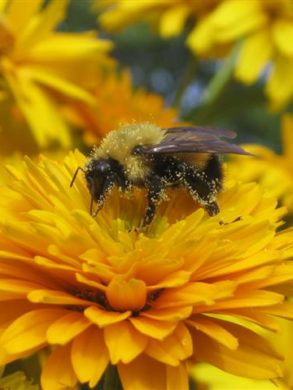10 Important Plants You Can Grow to Benefit Helpful Pollinators

We’ve all heard about how important pollinators are, but do we really know the extent of their helpfulness? With information found at Pollinator Partnership and their supporting research, we know that between 75-95% of all flowering plants on earth need help with pollination!
That is an amazing number. It shocked me! What’s equally surprising is the number of helpful friends there are who take the task of pollinating our fruits and vegetables. Butterflies, birds, bats, small mammals, moths, beetles, wasps, flies, and (the most well-known and important) bees visit all these flowering plants to drink nectar or feed off of pollen, then shake grains of pollen off of their bodies as they move from plant to plant.
What may be interesting for you to know is that you–the happy gardener–can help keep these species alive, content, and doing their essential life-sustaining job of pollinating! There are easy things you can do to help them, and planting particular beautiful flowers is an “everyone’s-a-winner” first step. This includes finding the right plants for pollinators (look for ones native to your area) and using succession planting to get a wide array of flowers that bloom at different times and have varied structure types. Though there isn’t an individualized “plants for pollinators” list based on geographical location, there is a wide variety mentioned here that will get you started on your journey to repaying the kindness to our helpful friends.
- LAVENDER (Lavendula)–I love me some lavender. Not only does it attract bees and hummingbirds, but it repels insects like mosquitoes and flies! Lavender is also a great addition to your medical garden.
- MARIGOLD (Calendula officinalis)–Attracts bees and butterflies as well as many other helpful insects that protect your garden like ladybugs, hoverflies, and lacewings. This flower can be a pest-attracter, but if you use it as a “trap crop”, it will draw things like aphids and whiteflies away from the other susceptible plants, and you can control the pests on the marigold instead of the entire garden. Marigold also has medicinal properties for us humans and is otherwise known as Calendula.
- SUNFLOWERS (Helianthus annuus)–Attract bees and birds and are just the happiest flowers in any garden. These flowers grow crazy tall, and are also heliotropic, which means that they turn their faces towards the sun to follow it throughout the day. Plant them in the right spot and you’ll have these beautiful smiling faces looking at you from dawn ‘til dusk!
- CONEFLOWER (Echinacea purpurea)—Attracts bumble bees, butterflies and birds. These flowers are low maintenance and will usually re-bloom without deadheading. Coneflowers, or echinacea, are also incredibly supportive to our immune function.
- COSMOS–Attracts birds, bees, butterflies, and moths. These colorful perennial flowers do well even in drought and poor-soil conditions.
- VERBENA (Vervain)–This is a great flower for the endangered Monarch butterflies as well as honey and bumble bees, hummingbirds, and moths. It’s a super low-maintenance plant with a long bloom period.
- SALVIA—Attracts bees, butterflies, and hummingbirds. Salvia is a group of plants that includes over 700 different kinds, including sage and even Chia plants!
- OREGANO–Attracts bees and lacewings. Not only is this plant helpful for pollinators, but it also acts as a natural insecticide against other common garden pests. Oregano is tasty in our dishes and a fighter for our health.
- MILKWEED–This is the plant that Monarch butterflies eat exclusively, and, because of the increasing use of pesticides, they are able to find less and less healthy milkweed to feed off of.
- ZINNIA–Attracts bees and butterflies (Monarchs). These big, beautiful flowers come in many colors and sizes, and are low-maintenance plants that mature quickly with long-lasting blooms. They are most often planted near vegetable gardens to entice bees to pollinate.
This list just focuses on plants for pollinators that either serve multiple purposes or help a particular pollinator facing extinction. For another list of helpful, beautiful flowers you and the pollinators will love, check out our friend’s list at Happy DIY Home!
Pesticides and diseases, among other human interventions, are two of the most dangerous things affecting pollinators today. These very things are the reason the number of pollinators is dwindling down every single day. But we can help with that too! Planting organic flowers and using organic soil and feed are as important as the plants you put out for these little guys. If we’re trying to avoid pesticides in our foods because of the potential harm they can cause us, imagine the damage the chemicals can do to these teeny-tiny knights of Nature.
Click here for more resources and information about this topic.
You can click the button below to go back to the Gardening articles, or you can venture over to our DIY Gardening recipes and the Gardening supplies and products we love!
Disclaimer: All information contained herein is intended for educational purposes only. It is not provided to diagnose, prevent, or treat any disease, illness, or injured condition for any human or animal, and Mother Nature’s Truths, as well as the author(s), contributor(s), publishers, and owners accept no responsibility for such use. Anyone suffering from any disease, illness, or injury, or who has an animal suffering from such, should consult with their physician or veterinarian. The statements herein have not been evaluated by the Food and Drug Administration.